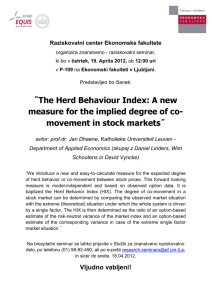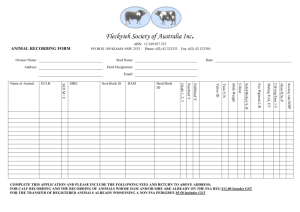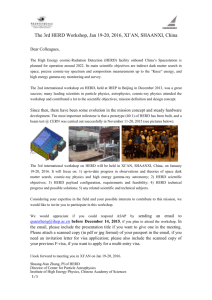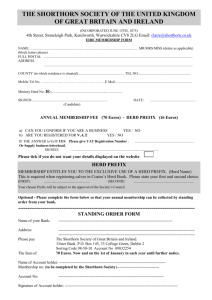Fact sheet Elections to exit the herd scheme What is changing
advertisement
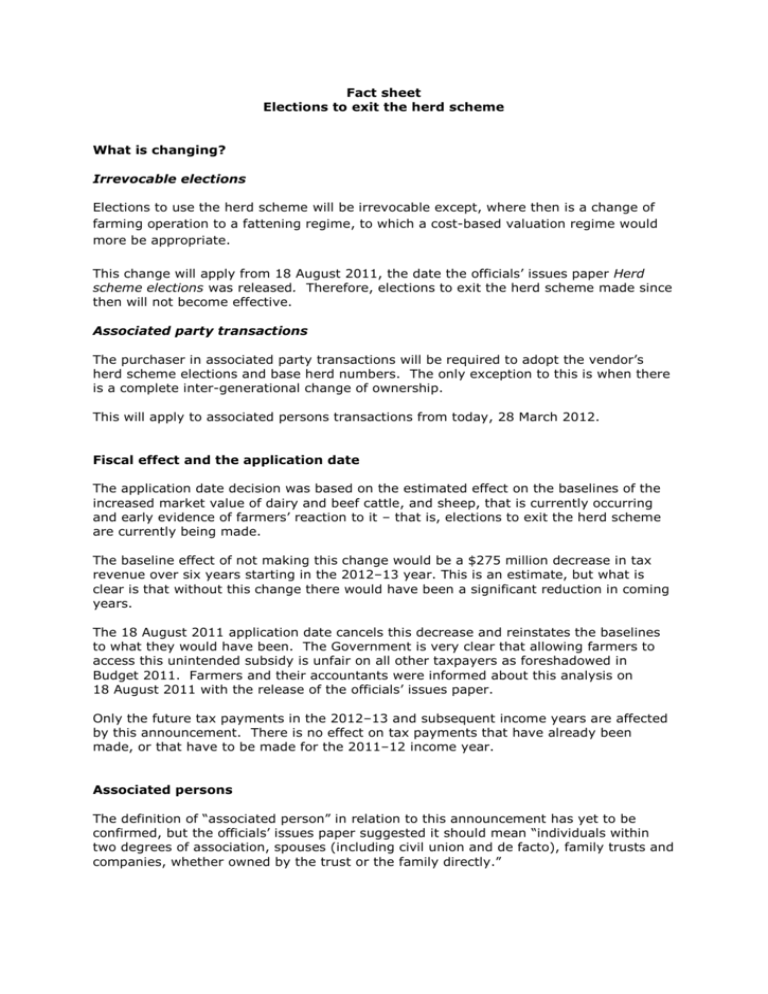
Fact sheet Elections to exit the herd scheme What is changing? Irrevocable elections Elections to use the herd scheme will be irrevocable except, where then is a change of farming operation to a fattening regime, to which a cost-based valuation regime would more be appropriate. This change will apply from 18 August 2011, the date the officials’ issues paper Herd scheme elections was released. Therefore, elections to exit the herd scheme made since then will not become effective. Associated party transactions The purchaser in associated party transactions will be required to adopt the vendor’s herd scheme elections and base herd numbers. The only exception to this is when there is a complete inter-generational change of ownership. This will apply to associated persons transactions from today, 28 March 2012. Fiscal effect and the application date The application date decision was based on the estimated effect on the baselines of the increased market value of dairy and beef cattle, and sheep, that is currently occurring and early evidence of farmers’ reaction to it – that is, elections to exit the herd scheme are currently being made. The baseline effect of not making this change would be a $275 million decrease in tax revenue over six years starting in the 2012–13 year. This is an estimate, but what is clear is that without this change there would have been a significant reduction in coming years. The 18 August 2011 application date cancels this decrease and reinstates the baselines to what they would have been. The Government is very clear that allowing farmers to access this unintended subsidy is unfair on all other taxpayers as foreshadowed in Budget 2011. Farmers and their accountants were informed about this analysis on 18 August 2011 with the release of the officials’ issues paper. Only the future tax payments in the 2012–13 and subsequent income years are affected by this announcement. There is no effect on tax payments that have already been made, or that have to be made for the 2011–12 income year. Associated persons The definition of “associated person” in relation to this announcement has yet to be confirmed, but the officials’ issues paper suggested it should mean “individuals within two degrees of association, spouses (including civil union and de facto), family trusts and companies, whether owned by the trust or the family directly.” However, where a farmer ceases farming by completely selling the farming operation to his or her children (or grandchildren), it was argued in submissions that the new generation should be allowed a one-off opportunity to exit from the herd scheme. For such an inter-generational sale relief to qualify, the vendor would have to completely dispose of his or her direct and indirect interests in the farm. For example, the vendor could not be a beneficiary of a trust that directly or indirectly owned the farm, or potentially be added to the list of beneficiaries. However, any loans left in on the sale would not count as an interest in the farm. Sharemilkers buying their first farm Submissions were made recommending that sharemilkers be allowed to elect out of the herd scheme when they down-size their herd to buy their first farm. The tax advantage generated by exiting the herd scheme is often part of the funding analysis that leads to the purchase. Merely banking the tax opportunity of the write-down from herd values to national standard costs (NSC) is insufficient reason to allow this. Background There are effectively two ways that farmers value their livestock (mainly beef and dairy cattle, and sheep (but also deer, goats and pigs)), at balance date for tax purposes. The herd scheme treats livestock more as if they were a capital asset by using national average market values (commonly called “herd values”) with changes in values from year to year on tax-free capital account. National standard cost or NSC is similar to a typical trading stock scheme where changes in values from year to year are on tax account. The major difference from a standard trading stock scheme is that on-farm costs for breeding, rearing and growing home-bred livestock are, for simplicity, standardised nationally. As could be expected for a home-bred operation, herd values generally exceed NSC. It is this difference that gives rise to the tax advantage that was the subject of the officials’ consultation paper. This difference is tax-deductible to a farmer who elects to exit the herd scheme, usually over about six years as replacement livestock are home-bred. Further, farmers could elect out of the herd scheme with a short advance notice period. While most farmers have observed the long-term nature of the herd scheme election and have not made elections to exit it, the present high prices for sheep, and dairy and beef cattle has created a tax planning opportunity for farmers who are using the herd scheme to value their livestock to elect to exit the herd scheme by 31 March 2012, effective for the 2012–13 income year. A similar opportunity existed for dairy farmers for the 2008–09 year income year. The implications of this earlier opportunity were illustrated in detail in the officials’ issues paper. An example from that paper is illustrated below. There is evidence that a few dairy farmers have, in the period since 2008, elected out of the herd scheme to derive a tax advantage, then elected back in, and are now electing out again to derive the same tax advantage. This also points to the reason why the election will be irrevocable – the alternative of lengthening the election period still allows choice and merely makes it harder to seek the tax advantage, rather than eliminating the opportunity. However, there can be legitimate reasons for electing out of the herd scheme – any change in a farming regime from, say, beef breeding to a beef fattening regime is an example of this. The new rules will explicitly recognise this. Likely other changes The officials’ issues paper also discussed the general cessation of farming election where the farm is sold to a third party. It noted that the election rules around this produced a bias against the government. During consultation there seemed to be no disagreement with addressing this. During consultation other helpful suggestions were made, such as combining the classes for Jersey and Friesian dairy cattle. These matters will be considered by Ministers over the next month or two. Consultation on detail There will be an opportunity for the private sector to review the technical detail associated with the decision. Given the technical nature of these changes, this will help ensure that the amendments are correct. Example This example is Example 6 (page 15) of the officials’ issues paper. Using a herd of 300 dairy cows (the average herd was about 350 dairy cows) and 120 replacement R 1 and R 2 heifers (60 of each) the tax valuations around this 2008 period are illustrated below. Admittedly this is a worst case scenario and most dairy farmers did not make any of the elections referred to below. The example from the issues paper: Example 6: Election back into the herd scheme Year Valuation election Opening stock Closing stock Tax account Capital account 2008 Herd 473,640 818,580 Nil 344,940 2009 NSC 818,580 745,392 (73,188) Nil 2010 Herd 745,392 521,220 (224,172) Nil The 2006–07 year By the time this tax return would typically have been filed it would have been very clear that the 2008 herd values were going to be high. A number (but nowhere near a majority) of dairy farmers, who were using the herd scheme, elected with their 2006–07 tax return that they would exit the herd scheme effective for the 2008–09 income year. The tax return filing rules allow for this 2006–07 tax return to have been filed as late as 31 March 2008. The 2007–08 year In the farmer’s 2007–08 income year the farmer derived a tax-free write-up of $345,000 from the lower 2007 herd values to the higher 2008 herd values. The herd scheme methodology provides that this is tax-free. There is no policy problem with this. The 2008–09 year The farmer’s opening livestock was valued at the high 2008 herd values and the closing stock was valued using the cost-based NSC. The replacement stock (the heifers born in 2008) would be valued at cost, whereas the stock that was on hand at the start of the year (now the R 2 heifers and the remaining MA cows) would be valued at the opening herd values (and in the case the R 2 heifers a cost for growing them for the year would also be included). The effect is that the difference between the opening and closing values yields a tax deduction of about $73,000. The 2009–10 year If no election was made to re-join the herd scheme in this or future years, further deductions would be available. Over the 2008–09 and subsequent years these deductions would total about $500,000. However, some farmers who elected out for the 2008–09 year elected back in for the 2009–10 year. There is no analysis of how many of the dairy farmers that elected out of the herd scheme for the 2008–09 income year have elected back in for this year. As is illustrated in the table above, the herd scheme values for 2010 fell considerably from their 2008 values and a further write down to these lower herd scheme values resulted in a tax deduction for this year of $224,000.


